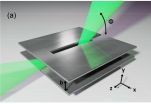(Press-News.org) Montreal, September 14, 2015 - Using extensive genetic data compiled by the UK10K project, an international team of researchers led by Dr. Brent Richards of the Lady Davis Institute at the Jewish General Hospital has identified a genetic variant near the gene EN1 as having the strongest effect on bone mineral density (BMD) and fracture identified to date. The findings are published in the forthcoming issue of the prestigious journal Nature.
"EN1 has never before been linked to osteoporosis in humans, so this opens up a brand new pathway to pursue in developing drugs to block the disease," Dr. Richards, an Associate Professor of Medicine at McGill University, says by way of explaining the importance of the discovery.
"The effect of this uncommon genetic variant that we identified in this gene is twice as large as any previously identified genetic variants for BMD and fracture," adds Vince Forgetta, first author on this collaborative project from the Genetic Factors for Osteoporosis Consortium, and a Research Associate at the Lady Davis Institute.
Osteoporosis is a common disease that will lead to fractures in between one-third and one-half of all women over the course of their lives. Because osteoporosis becomes more severe with age, it is becoming more prevalent with the overall aging of the population. There are currently few safe and effective treatments for osteoporosis, and no curative therapies available.
The UK10K project has measured genetic variations in 10,000 individuals in great detail, allowing researchers to correlate rare genetic changes with human disease by comparing the DNA of healthy individuals with those who have health problems. The use of such an extensive sample size allows for the observation of genetic variants that are not discernable among smaller groups. This particular study also stands as proof of principle that uncommon genetic variants can have a significant impact on common diseases.
"The hypothesis is that the genetic sequencing being done by UK10K will expose previously unknown genetic factors underlying disease," said Dr. Celia Greenwood, a biostatistician who is Senior Investigator at the Lady Davis Institute and Associate Professor at McGill University, and co-chaired the statistics group for a companion Nature article on the methodology behind UK10K. "We are finally able to extract enough data to discern variants that are rare in the overall population and are more frequent among those with common diseases. This is precisely what has been revealed in the case of EN1 and osteoporosis."
This study represents an initial realization of the hope that accompanied the development of genetic sequencing technology: that sophisticated analysis of the genome would reveal those genes associated with disease. The promise for the contribution genetics can make to human health lies in the discovery of novel compounds that can counter the effect of deleterious genetic variants influencing these genes.
INFORMATION:
"Whole-genome sequencing identifies EN1 as a determinant of bone density and fracture" by J. Brent Richards et al, Nature, on-line September 14, 2015.
http://www.nature.com/nature/journal/vaop/ncurrent/full/nature14878.html
See also, "The UK10K project identifies rare variants in health and disease," Nature, September 14, 2015.
For more about the Lady Davis Institute: http://www.ladydavis.ca
For more about the Jewish General Hospital: http://www.jgh.ca
BLOOMINGTON, Ind. -- A study three years ago sparked a medical mystery when it revealed a part of the brain not found in any present-day anatomy textbooks.
Recently, Indiana University computational neuroscientist Franco Pestilli and an international research team published an article in the journal Cerebral Cortex that suggests this missing part of the brain may play an important role in how we understand the world -- despite getting "lost" for more than a century.
A long flat bundle of nerves called the vertical occipital fasciculus, or VOF, the structure appeared ...
Researchers at Cardiff University have devised a way of increasing the yield of biodiesel by using the waste left over from its production process.
Using simple catalysis, the researchers have been able to recycle a non-desired by-product produced when biodiesel is formed from vegetable oil, and convert this into an ingredient to produce even more biodiesel.
It is believed this new process will have significant environmental benefits by improving the yield of biodiesel in a sustainable way that doesn't require the use of additional fossil fuels, and could potentially ...
PROVIDENCE, R.I. [Brown University] -- Terahertz radiation could one day provide the backbone for wireless systems that can deliver data up to one hundred times faster than today's cellular or Wi-Fi networks. But there remain many technical challenges to be solved before terahertz wireless is ready for prime time.
Researchers from Brown University have taken a major step toward addressing one of those challenges. They've developed what they believe to be the first system for multiplexing terahertz waves. Multiplexers are devices that enable separate streams of data to ...
(SACRAMENTO, Calif.) -- Vitamin D insufficiency among the elderly is highly correlated with accelerated cognitive decline and impaired performance, particularly in domains such as memory loss that are associated with Alzheimer's disease and dementia, researchers with the UC Davis Alzheimer's Disease Center and Rutgers University have found. The effect is "substantial," with individuals with low vitamin D declining at a rate three times faster than those with adequate vitamin D levels.
The researchers said their findings amplify the importance of identifying vitamin D ...
Vitamin D insufficiency was associated with faster decline in cognitive functions among a group of ethnically diverse older adults, according to an article published online by JAMA Neurology.
In addition to promoting calcium absorption and bone health, vitamin D may influence all organ systems. Both the vitamin D receptor and the enzyme that converts 25-hydroxyvitamin D (25-OHD) to the active form of the vitamin are expressed in all human organs, including the brain. Thus, research has increasingly examined the association between vitamin D status and a variety of health ...
To encourage hospitals to improve quality of care, Medicare penalizes those with higher than expected rates of readmission within 30 days of discharge. The logic behind the penalties is that if patients receive high quality care, including proper discharge planning, they should be less likely to end up back in the hospital.
This seems straightforward, but it turns out that the social and clinical characteristics of a hospital's patient population that are not included in Medicare's calculation explain nearly half of the difference in readmission rates between the best- ...
Black children were less likely to receive any pain medication for moderate pain and less likely to receive opioids for severe pain than white children in a study of racial disparities in the pain management of children with appendicitis in emergency departments, according to an article published online by JAMA Pediatrics.
Racial and ethnic differences in the emergency department (ED) management of pain have been described, with lower rates of opioid prescription for black and Hispanic patients than for white patients. However, there are fewer studies in children. Appendicitis ...
The largest population genome sequencing effort to date is published today in Nature. A series of papers describing resources and application of the data is published at the same time in Nature, Nature Genetics, Bioinformatics and Nature Communications.
Rare genetic variants are changes in DNA that are carried only by relatively few people in a population. The UK10K study was designed to explore the contribution of these rare genetic variants to human disease and its risk factors.
"The project has made important new contributions towards describing the role of rare ...
This news release is available in Spanish.
Final OS and subgroup analysis of the pivotal study SAR-3007
First interim results of the Y-IMAGE prospective study showing real-world data for trabectedin in advanced soft tissue sarcoma (STS)
Clinical data of trabectedin in translocated-related sarcomas, and in advanced leiomyosarcomas and liposarcomas
Early clinical studies of PM1183 in combination with paclitaxel or cisplatin show a synergistic activity
Madrid, September 14, 2015: PharmaMar announces that it will show new data from clinical pivotal ...
This news release is available in French. We have known for some years that Alzheimer's disease is characterised by two types of lesions, amyloid plaques and degenerated tau protein. Cholesterol plays an important role in the physiopathology of this disease. Two French research teams (Inserm/CEA/University of Lille/University of Paris-Sud ) have just shown, in a rodent model, that overexpressing an enzyme that can eliminate excess cholesterol from the brain may have a beneficial action on the tau component of the disease, and completely correct it. This is the first ...



